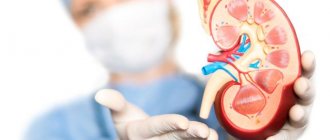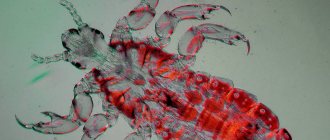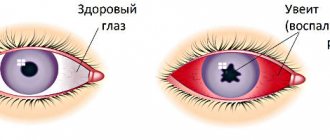Urolithiasis
(urolithiasis) is a disease characterized by the formation of stones in the urinary organs. Stones can be found in all organs of the urinary system, however, they most often occur in the kidneys and bladder. Also a serious problem are stones in the ureter, where they enter after descending from the kidneys. Urolithiasis can develop at any age, but most cases of its initial detection occur between the ages of 20-55 years.
Causes of urolithiasis
The appearance of stones indicates metabolic disorders, as a result of which insoluble salts begin to accumulate in the body. It is believed that the tendency to urolithiasis is congenital, but stones will not appear without the influence of one of the additional factors, including:
- hot climate, provoking active sweating;
- composition of drinking water (hard water promotes stone formation);
- addiction to spicy, salty and sour foods, excess calcium and animal protein in food;
- lack of vitamins (A and group B), ultraviolet radiation (life “without the sun”);
- severe dehydration, for example as a result of infectious diseases;
- sedentary lifestyle, including forced inactivity as a result of injuries;
- chronic diseases of the stomach and intestines (gastritis, colitis, peptic ulcer);
- diseases of the kidneys and other organs of the genitourinary system (pyelonephritis, cystitis, prostate adenoma, prostatitis);
- metabolic diseases (for example, gout).
Causes of stone formation
The problem arises when there is a lot of calcium and uric acid in the urine and at the same time there is not enough water, which blurs the crystalline substances, makes the urine more alkaline, and prevents small pebbles from sticking together.
The problem has 5 main types. In 90% of cases it is caused by calcium oxalate and calcium phosphate stones.
Calcium oxalate stones
Calcium oxalate is created daily by the liver. The substance is also found in food - chocolate, fruits, nuts, vegetables.
Vitamin D also contains a lot of calcium oxalate, so you need to be careful when taking medications that contain it.
The appearance of this type of stones can be caused by:
- gastric bypass, which is done to lose weight;
- some metabolic pathologies.
Calcium phosphate
Concretions from this substance are generated by:
- migraines;
- certain anticonvulsant drugs (topiramate);
- renal tubular acidosis.
Struvite stones
Born of infections. They quickly become very bulky. If not treated in time, the stones will block the flow of urine and cause serious complications. They can only be removed surgically.
Uric acid (urate) crystal stones
Appears in people:
- those who do not drink enough fluid lose it suddenly (for example, during intense sports);
- are on a high protein diet;
- suffer from gout.
Cystene stones
They affect people with a very rare genetic disease (cystinuria), due to which vital amino acids are excreted from the body in large quantities.
The problem is also generated by:
- hyperparathyroidism (problems with the parathyroid gland);
- some congenital pathologies (spongy kidney, Dent's syndrome);
- inflammatory bowel diseases (Crohn's disease), chronic diarrhea.
The causes of urolithiasis in men are varied.
Read also: Cystitis in men: symptoms, treatment, signs
Symptoms of urolithiasis
The main symptom is pain, the localization of which depends on the organ in which the stones are located. The hard body of the stone injures the organ, especially when moving.
Symptoms of kidney stones
Kidney stones manifest themselves as pain in the lumbar region on one or both sides (depending on whether there are stones in one or both kidneys). As a rule, the pain is dull, aching in nature. Pain sensations change with movement or change in body position. Blood may be found in the urine after an attack of severe pain, walking or physical activity. Stones may also pass (stones are carried away by a stream of urine).
If the kidney stone is small, there may be no obvious symptoms.
Symptoms of stones in the ureters
Stones in the ureter cause pain, the location of which changes as the stone moves: the pain moves from the lower back to the groin, lower abdomen or genitals.
The stone can completely block the lumen of the ureter. In this case, urine accumulates in the kidney, causing severe pain ( renal colic
). The pain can last for hours (up to several days), and only stops when the stone passes from the ureter into the bladder. In case of renal colic, emergency medical care is required (you must call 03).
A stone in the lower ureter may cause frequent urination.
Symptoms of bladder stones
The presence of stones in the bladder is manifested by pain in the lower abdomen, radiating to the perineum or genitals, primarily during movement or urination. Sudden movements can also trigger the urge to urinate (a symptom of frequent urination). During urination, the stream of urine may be interrupted and resumed only when the stone moves as a result of a change in body position.
Methods for diagnosing urolithiasis
A stone is, in fact, a foreign object, and its existence in the organs of the urinary system can lead to serious consequences.
Stones in the kidneys and ureter over time lead to the development of pyelonephritis in acute or chronic form; and in the absence of proper treatment, relapses of pyelonephritis and impaired urine flow can cause kidney death. Bladder stones can cause inflammation of the mucous membrane (cystitis). Therefore, if you notice symptoms of urolithiasis, you should definitely consult a doctor. To confirm the diagnosis, an ultrasound or x-ray examination, urine and blood tests are usually performed.
General blood analysis
A general blood test allows you to identify the inflammatory process, which in a significant number of cases is present in urolithiasis. However, if there is no inflammation, the test results may remain within normal limits.
More information about the diagnostic method
General urine analysis
In case of urolithiasis, a general urine test may show an admixture of blood (the result of stones injuring the organs of the urinary system). Also, urolithiasis is characterized by the presence of salts and protein in the urine. With the development of inflammation, leukocytes and bacteria are detected in the urine.
To obtain a more complete picture, in addition to the clinical analysis, tests according to Nechiporenko and Zimnitsky can be prescribed.
More information about the diagnostic method
Blood chemistry
A biochemical blood test for urolithiasis makes it possible to evaluate metabolic disorders that cause the stone formation process. Attention is paid to the level of electrolytes, creatinine, calcium and phosphorus, uric acid, and parathyroid hormone.
More information about the diagnostic method
Biochemical urine analysis
Biochemical urine analysis is used to determine the composition of stones (this is necessary to decide on treatment tactics). Biochemical analysis indicators make it possible to judge not only metabolic disorders in the body, but also the functional state of the kidneys. For this purpose, daily urine output is collected (daily urine analysis).
More information about the diagnostic method
X-ray of the abdominal cavity
When complaining of abdominal pain, a plain radiography of the abdominal organs is usually performed. This study allows us to discover the cause of complaints. In particular, X-rays will allow you to detect the shadows of stones in the projection of the urinary system. However, there are stones that are not x-ray positive; they cannot be detected using this method.
More information about the diagnostic method
Ultrasound examinations
Ultrasound of the urinary system can reveal the presence of stones, their location, number and size. Ultrasound can detect urate and cystine stones that are not visible on x-rays. If an ultrasound is performed based on the results of a plain radiography, it may be aimed at examining a specific organ - the kidneys or bladder. It is usually not possible to detect stones in the ureters using ultrasound (with the exception of the uppermost and lowermost sections). Ultrasound of the kidneys also allows you to determine the size of the kidneys, the condition of the pelvis and calyces, and possible concomitant pathologies.
More information about the diagnostic method
Excretory urography
The excretory urography method involves preliminary intravenous administration of a radiocontrast agent. Using excretory urography, evaluate renal function, the structure of the abdominal system and the patency of the ureters. Used to definitively confirm the diagnosis.
More information about the diagnostic method
Computed tomography (CT)
Computed tomography of the kidneys is the most informative diagnostic method. Allows you to see almost all types of stones. However, compared to x-rays and ultrasound, this is a more expensive test.
More information about the diagnostic method
Sign up for diagnostics To accurately diagnose the disease, make an appointment with specialists from the Family Doctor network.
Medicines and substances that increase risk
- Acetazolamide
- Efilrin
- Phosphate-binding anatcides
- Uricosuric substances
- Calcium/Vitamin D
- Guaifenesin
- Topiramate
- Triamterene
- Vitamin C
In modern medicine there is no remedy that cures urolithiasis. After pain relief and stone removal, the only goal is to prevent relapse
The process of stone formation can be controlled. Proper nutrition and plenty of water in the diet will reduce the likelihood of recurrence.
Treatment methods for urolithiasis
Treatment of urolithiasis is mainly surgical - an operation is performed to remove the stones. If the stones are formed by uric acid salts, their dissolution is possible. In this case, a course of special medications is prescribed.
However, if the conditions that caused the stone formation remain the same, then the stones may appear again after they are removed. To avoid this, a course of preventive treatment is carried out, including adherence to a special diet, medication, maintaining the necessary water balance, and physical therapy.
By contacting JSC “Family Doctor” with complaints about a disease of the urinary organs, you will receive advice from qualified urologists. Their experience, as well as equipping the Family Doctor clinics with modern equipment, including its own laboratory, will allow you to quickly and accurately establish a diagnosis and prescribe effective treatment. Stone removal is carried out in the Hospital.
Removing Stones
Currently, stone removal is usually done using minimally invasive methods. Laparoscopy and open surgery should be resorted to only in extreme cases. First of all, methods such as pyelolithotripsy are used (stones are destroyed as a result of mechanical, ultrasound or laser action using instruments placed along the natural urinary tract) and percutaneous nephrolitholapaxy (removal is performed through an incision in the lumbar region. This is how large and coral-shaped stones are removed).
Make an appointment Do not self-medicate. Contact our specialists who will correctly diagnose and prescribe treatment.
Before it’s too late, drink Borjomi!
There is no point in relying on medications that dissolve kidney stones. Today, despite the assurances of various commercials, there are no drugs that can dissolve formed oxalate and phosphate kidney stones (and these are the ones that occur in most patients). Only uric acid stones (urates) can be dissolved, and then only in some cases.
The mineral waters of our resorts can be recommended as a treatment only if the stone is small and can therefore easily be removed from the body. And what you definitely shouldn’t do is go to a resort against the opinion of a doctor who is offering you surgical removal of the stone. Moreover, today very gentle operations are possible.









